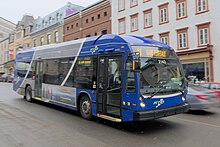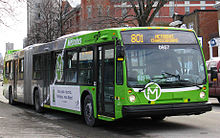You can help expand this article with text translated from the corresponding article in French. (December 2022) Click [show] for important translation instructions.
|
The Réseau de transport de la Capitale (French pronunciation: [ʁezo də tʁɑ̃spɔʁ də la kapital], RTC), the brand name for the Société de transport de Québec, provides urban public transit services in the Quebec City area. It was founded in 2002, continuing the operations of the former Société de transport de la Communauté urbaine de Québec, as the latter was merged into the new Quebec City.
| Réseau de transport de la Capitale | |
|---|---|
 | |
 Nova Bus LFS HEV operating regular service | |
 Nova Bus LFS Artic operating Métrobus service | |
| Overview | |
| Transit type | Bus service, bus rapid transit, paratransit |
| Number of lines | 160[1] |
| Number of stations | 4383 stops[1] |
| Daily ridership | 70,000[1] |
| Annual ridership | 26,584,232 (2023)[1] |
| Headquarters | 720, rue des Rocailles Quebec City, Quebec G2J 1A5 |
| Website | English language site |
| Operation | |
| Began operation | 2002 |
| Number of vehicles | 630 buses, 114 articulated buses, 64 midibuses[1] |
History
editEarly public transit in Quebec City
editBefore the bus, public transit was provided in the form of a tramway operated by the Quebec Railway, Light & Power Company. It was initially horse-drawn in 1863, and made electric in 1897. This network connected the upper and lower towns. It was extended in 1910 to Sillery via Boulevard Saint-Cyrille (later renamed Boulevard René-Lévesque) and Rue Sheppard, to Avenue Maguire. A new line was established in 1912 connecting the historic district of Beauport to the Kent House. The tramway began to be converted to buses in 1937, and this conversion was complete by 1948 with the closure of the line in Saint-Sauveur.[2]
Modern period
editThe modern public transit system was born on November 23rd 1969 with the Loi de la Communauté urbaine de Québec. It took the name Commission de transport de la Communauté urbaine de Québec (CTCUQ).[3] The CTCUQ improved transit in Quebec City in numerous ways: dedicated bus lanes on certain arterial roads in 1975, express routes in 1977, and the establishment of the Parc-O-Bus in 1980. In this period, it also acquired multiple private bus companies and standardized fares.
The organization underwent a major reorganization in 1992, and a recovery plan was implemented. Most notably, this plan put in place the Métrobus and Couche-tard services, more dedicated bus lanes, and network changes. The CTCUQ became the Société de transport de la Communauté urbaine de Québec (STCUQ) in 1994. Following the municipal reorganizations of Quebec in 2002, it briefly became the Societé de transport de Québec, and finally, the Réseau de transport de la Capitale (RTC). The ridership of this network grew substantially in this period, reaching a ridership of 41.3 million in 2007. A system of electric minibuses known as Écolobus was added to the system in 2008, but later phased out in 2015.[4] Additionally, the Opus card was implemented for fare payment on buses.
The RTC acquired 101 hybrid buses from 2012 to 2015.[5] It has also implemented an intelligent transportation system implementing GPS tracking. A bus network computerization project known as RTC Nomade was implemented over 10 years that allows passengers to view live locations of buses online, on bus information screens, through bus audio announcements, and at stations.
Operations
editMétrobus
editThe RTC operates six high-frequency lines under the Métrobus brand: lines 800 through 804, and 807. Lines 800 and 801 run together from De Marly to Dorchester/de la Couronne. Line 801 continues on to Terminus du Zoo, while line 800 diverges to the Montmorency falls. Line 802, runs from Terminus Beauport to Station Belvédère. Then, line 803 runs from Terminus les Saules to Terminus Beauport, through Le Mesnil, Lebourgneuf and Charlesbourg. Line 804, links Sainte-Foy with Loretteville going through the Terminus les Saules and the Université Laval campus and then finally the 807 goes between De Marly and Place D'Youville by riding along the Chemin Sainte-Foy until it merges to Rue Saint-Jean. Service is every 5 minutes during peak times, every 10 minutes before and after then, and every 15 minutes during less-travelled times.[6]
Other services
edit- Parc-O-Bus: select parking lots to encourage use of public transit
- STAC: Service de transport adapté de la Capitale: paratransit for the physically challenged
- Taxibus:an on-call taxi service connecting passengers in remote areas to the nearest bus stop
- Flexibus: an on-demand transit service in certain areas poorly served by conventional transit[7]
Future projects
editA study concluded in March 2003, stated the introduction of light rail transit services would be feasible for the entire area. In March 2018, a $3 billion proposal for a combination of tramways (the Quebec City Tramway), an electric trambus and reserved bus lanes was announced.[8]
In November 2019, the Réseau de transport de la Capitale announced that it is planning to open the city's first BRT line along Boulevard Charest by 2026, utilizing a fleet of bi-articulated electric buses.[9]
Fleet
editActive
- Nova LFS HEV (2010, 2015-2021)
- Nova LFS Artic (2009-2012)
- Nova LFS Artic HEV (2016, 2022-2023)
- Nova LFS (2006-2013)
- Van Hool A330K (2019)
The active fleet is wheelchair accessible.
-
2013 Nova Bus LFS
-
2022 Nova Bus LFSe+
-
2010 Nova Bus LFS Artic
-
2023 Nova Bus LFS Artic HEV
-
Inside of an articulated LFS HEV (Métrobus service)
-
Inside of a regular LFS (regular service)
Retired
- GM New Look (1959-1985) (T6H-5307)
- MCI Classic Gray Line (1983-1986-1988-1989)
- MCI Classic Articulated (1992) (TC60-102N)
- MCI Classic (1990-1992) (TC40-102N)
- GM Classic (1983-1986) (TC40-102N)
- Nova LFS (1996, 1998, 1999-2005)
- Nova Bus Classic (1994-1996) (TC40-102N)
- Tecnobus Gulliver (2008)
- Orion II (1994)
-
1986 GM Classic
-
2000 Nova Bus LFS
-
2008 Technobus Gulliver
References
edit- ^ a b c d e [1]
- ^ "Ville de Québec - Tramways". archive.wikiwix.com. Retrieved 2024-01-09.
- ^ "RTC - Historique". archive.wikiwix.com. Retrieved 2024-01-09.
- ^ "La fin pour les Écolobus - Actualités - Québec Hebdo". 2016-03-04. Archived from the original on 2016-03-04. Retrieved 2024-01-09.
- ^ "RTC - Quoi de neuf?". archive.wikiwix.com. Retrieved 2024-01-09.
- ^ "RTC : deux nouveaux parcours Métrobus à Québec". Sympatico (in Canadian French). Archived from the original on 2017-03-23. Retrieved 2017-03-22.
- ^ "Réseau de transport de la Capitale". www.rtcquebec.ca. Retrieved 2024-01-09.
- ^ Page, Julia (March 16, 2018). "Quebec City unveils plans for $3-billion tramway network, wants feds and province to pay". CBC News. Retrieved 19 March 2018.
- ^ "Le Tramway De Québec". Réseau (in French). Retrieved 2020-01-10.
External links
editMedia related to Réseau de transport de la Capitale at Wikimedia Commons